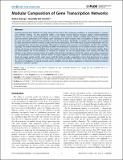Modular Composition of Gene Transcription Networks
Author(s)
Gyorgy, Andras; Del Vecchio, Domitilla
DownloadGyorgy-2014-Modular composition.pdf (956.4Kb)
PUBLISHER_CC
Publisher with Creative Commons License
Creative Commons Attribution
Terms of use
Metadata
Show full item recordAbstract
Predicting the dynamic behavior of a large network from that of the composing modules is a central problem in systems and synthetic biology. Yet, this predictive ability is still largely missing because modules display context-dependent behavior. One cause of context-dependence is retroactivity, a phenomenon similar to loading that influences in non-trivial ways the dynamic performance of a module upon connection to other modules. Here, we establish an analysis framework for gene transcription networks that explicitly accounts for retroactivity. Specifically, a module's key properties are encoded by three retroactivity matrices: internal, scaling, and mixing retroactivity. All of them have a physical interpretation and can be computed from macroscopic parameters (dissociation constants and promoter concentrations) and from the modules' topology. The internal retroactivity quantifies the effect of intramodular connections on an isolated module's dynamics. The scaling and mixing retroactivity establish how intermodular connections change the dynamics of connected modules. Based on these matrices and on the dynamics of modules in isolation, we can accurately predict how loading will affect the behavior of an arbitrary interconnection of modules. We illustrate implications of internal, scaling, and mixing retroactivity on the performance of recurrent network motifs, including negative autoregulation, combinatorial regulation, two-gene clocks, the toggle switch, and the single-input motif. We further provide a quantitative metric that determines how robust the dynamic behavior of a module is to interconnection with other modules. This metric can be employed both to evaluate the extent of modularity of natural networks and to establish concrete design guidelines to minimize retroactivity between modules in synthetic systems.
Date issued
2014-03Department
Massachusetts Institute of Technology. Department of Electrical Engineering and Computer Science; Massachusetts Institute of Technology. Department of Mechanical EngineeringJournal
PLoS Computational Biology
Publisher
Public Library of Science
Citation
Gyorgy, Andras, and Domitilla Del Vecchio. “Modular Composition of Gene Transcription Networks.” Edited by Stanislav Shvartsman. PLoS Comput Biol 10, no. 3 (March 13, 2014): e1003486.
Version: Final published version
ISSN
1553-7358